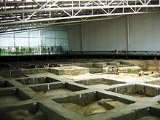
Jinsha
Encyclopedia
Jinsha is an archaeological site in Sichuan
, China
. Located in the Qingyang District
of Chengdu Prefecture
, Along the Modi River (摸底河. The Jinsha site was accidentally discovered in February 2001 during real estate construction. Located about 50 km away from Sanxingdui
, the site flourished around 1000 BCE and shares similarities in burial objects with the Sanxingdui site. Ivory, jade artifacts, bronze objects, gold objects and carved stone objects were found at the site. Unlike the site at Sanxingdui, Jinsha did not have a city wall. Jinsha culture (1200–650 BCE) was a final phase of Sanxingdui culture and represents a relocation of the political center in the ancient Shu Kingdom
. The city was built on the banks of the Modi River.
Sichuan
' , known formerly in the West by its postal map spellings of Szechwan or Szechuan is a province in Southwest China with its capital in Chengdu...
, China
China
Chinese civilization may refer to:* China for more general discussion of the country.* Chinese culture* Greater China, the transnational community of ethnic Chinese.* History of China* Sinosphere, the area historically affected by Chinese culture...
. Located in the Qingyang District
Qingyang District
Qingyang District is a district of Chengdu, the capital of Sichuan Province, China.Qingyang has an area of 68 square kilometers and a population of 460,000.-External links:*...
of Chengdu Prefecture
Chengdu
Chengdu , formerly transliterated Chengtu, is the capital of Sichuan province in Southwest China. It holds sub-provincial administrative status...
, Along the Modi River (摸底河. The Jinsha site was accidentally discovered in February 2001 during real estate construction. Located about 50 km away from Sanxingdui
Sanxingdui
Sanxingdui is the name of an archaeological site and its deduced culture in China, now believed to be the site of an ancient Chinese city. The previously unknown Bronze Age culture was re-discovered in 1987 when archaeologists excavated remarkable artifacts, that radiocarbon dating dated as being...
, the site flourished around 1000 BCE and shares similarities in burial objects with the Sanxingdui site. Ivory, jade artifacts, bronze objects, gold objects and carved stone objects were found at the site. Unlike the site at Sanxingdui, Jinsha did not have a city wall. Jinsha culture (1200–650 BCE) was a final phase of Sanxingdui culture and represents a relocation of the political center in the ancient Shu Kingdom
Shu (state)
The State of Shu was an ancient state in what is now Sichuan, China. It was conquered by Qin in 316 BC. Shu was based on the Chengdu Plain, in the western Sichuan basin with some extension northeast to the upper Han River valley. To the east was the Ba tribal confederation. Further east down the...
. The city was built on the banks of the Modi River.

